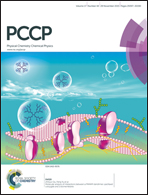Thermal decomposition of dolomite under CO2: insights from TGA and in situ XRD analysis
Abstract
Thermal decomposition of dolomite in the presence of CO2 in a calcination environment is investigated by means of in situ X-ray diffraction (XRD) and thermogravimetric analysis (TGA). The in situ XRD results suggest that dolomite decomposes directly at a temperature around 700 °C into MgO and CaO. Immediate carbonation of nascent CaO crystals leads to the formation of calcite as an intermediate product of decomposition. Subsequently, decarbonation of this poorly crystalline calcite occurs when the reaction is thermodynamically favorable and sufficiently fast at a temperature depending on the CO2 partial pressure in the calcination atmosphere. Decarbonation of this dolomitic calcite occurs at a lower temperature than limestone decarbonation due to the relatively low crystallinity of the former. Full decomposition of dolomite leads also to a relatively low crystalline CaO, which exhibits a high reactivity as compared to limestone derived CaO. Under CO2 capture conditions in the Calcium-Looping (CaL) process, MgO grains remain inert yet favor the carbonation reactivity of dolomitic CaO especially in the solid-state diffusion controlled phase. The fundamental mechanism that drives the crystallographic transformation of dolomite in the presence of CO2 is thus responsible for its fast calcination kinetics and the high carbonation reactivity of dolomitic CaO, which makes natural dolomite a potentially advantageous alternative to limestone for CO2 capture in the CaL technology as well as SO2in situ removal in oxy-combustion fluidized bed reactors.


 Please wait while we load your content...
Please wait while we load your content...